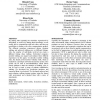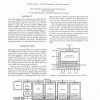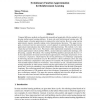401 search results - page 56 / 81 » Evolving a neural network using dyadic connections |
ECAL
2007
Springer
14 years 1 months ago
2007
Springer
Abstract. This paper investigates the processes used by an evolved, embodied simulated agent to adapt to large disruptive changes in its sensor morphology, whilst maintaining perfo...
CSCW
2000
ACM
14 years 4 days ago
2000
ACM
By sharing data regarding the sensations experienced by individuals, as well as by sharing their knowledge, we are readily able to communicate with each other, and there are possi...
MVA
1992
13 years 9 months ago
1992
This study reports on the performance of a Real-Time Vision System (RVS) and its use of an IMAP prototype LSI. This LSI integrates eight 8 bit processors and a 144 Kbit SRAM on a ...
CORR
2010
Springer
13 years 7 months ago
2010
Springer
Temporal difference methods are theoretically grounded and empirically effective methods for addressing reinforcement learning problems. In most real-world reinforcement learning ...
GECCO
2008
Springer
13 years 8 months ago
2008
Springer
Legged robots are useful in tasks such as search and rescue because they can effectively navigate on rugged terrain. However, it is difficult to design controllers for them that ...



